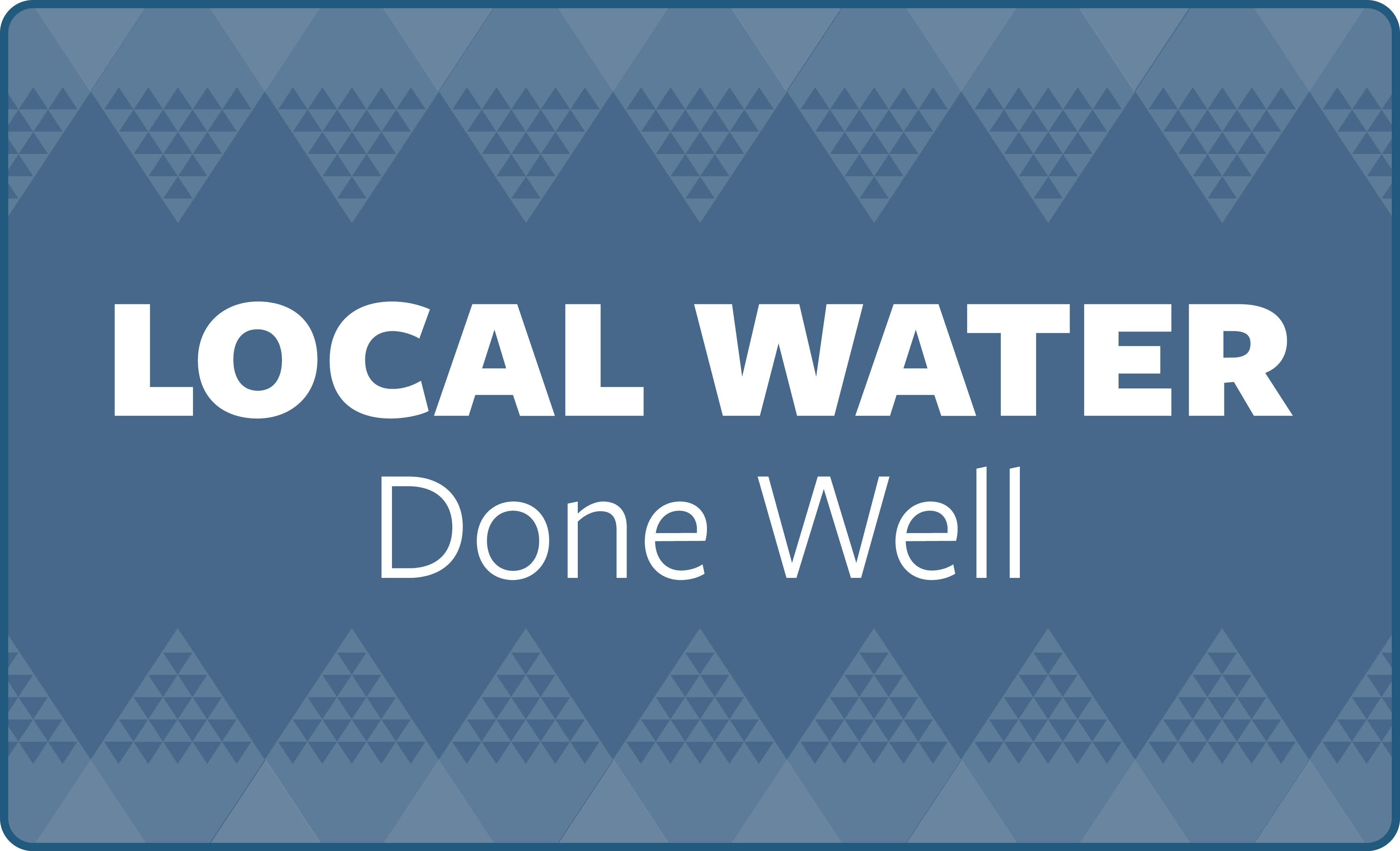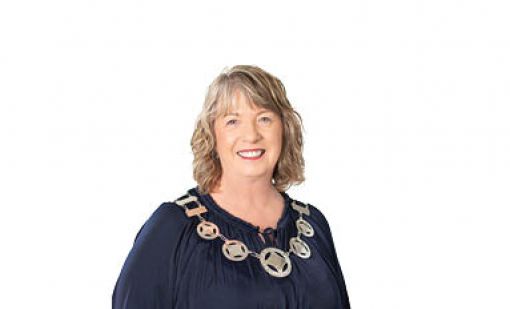Local Water Done Well
Tararua District Council are responding to new laws and the Governments “Local Water Done Well” policy and have looked at different ways to deliver water services in the future. Local Water Done Well is the Coalition Government’s plan to long-standing water infrastructure challenges. It replaces the previous government's Three Waters Reform programme but seeks to achieve similar water outcomes.
What is Local Water Done Well?
Key components of Local Water Done Well:
- fit-for-purpose service delivery models and financing tools
- ensuring water services are financially sustainable
- introducing greater central government oversight, economic and quality regulation.
Local Water Done Well is being implemented in three stages, each with its own piece of legislation.
- Repeal of previous water services legislation.
- Establish framework and preliminary arrangements for the new water services system.
- Establish enduring settings.
Local Water Done Well and the Tararua District
We have considered important factors such as the financial impact on water users, and the pros and cons of collaborating with neighbouring councils.
On Tuesday 4 November 2025, the four Wairarapa Tararua Councils – Masterton, Carterton, Tararua and South Wairarapa had their Water Services Delivery Plans approved by the Department of Internal Affairs (DIA). These plans set out the Councils’ intent to establish a new regional water organisation to deliver water services to their communities. Read the certified TDC Water Service Delivery Plan for full details. Read the associated media release here.
On Wednesday 24 September 2025, councillors unanimously approved the Constitution and Shareholders’ Agreement for Wairarapa Tararua Water Limited, which will become the Water Services Organisation (WSO) for South Wairarapa, Carterton, Masterton and Tararua.
The Constitution sets the legal foundations for the new company, while the Shareholders’ Agreement outlines how councils will work together as shareholders. It also establishes a Stakeholders Forum, giving both councils and iwi representatives a voice.
On Friday 29 August 2025, Tararua District Council, along with the Wairarapa councils, put forward a draft Joint Water Services Delivery Plan to the Secretary for Local Government, in the Department of Internal Affairs. Once approved, the WSO will be legally established by 1 July 2026 and take over day-to-day water services from 1 July 2027. Each council will be a shareholder in the company, while operations will be managed regionally.
On Wednesday 20 August 2025, Tararua District Council formally resolved to join the proposed Wairarapa Tararua Council Controlled Organisation (CCO), marking a critical step in securing the district's water infrastructure future under the Government's Local Water Done Well reform programme.
The decision confirms Tararua's commitment to the collaborative regional model, with all four councils agreeing to put forward a joint Water Services Delivery Plan to the Secretary for Local Government, in the Department of Internal Affairs.
The council-controlled organisation or Water Service Organisation, if approved, would be responsible for delivering drinking water, wastewater, and stormwater services across the four districts, managing approximately 25,000 connections.
Councils will be shareholders in the new water services organisation and will be able to influence and control aspects of how the new organisation will deliver water services to the wider area.
The resolution follows community consultation earlier this year, where 65% of Tararua submitters favoured the regional model.
Comprehensive planning has been completed, including worst-case scenario modelling, hydraulic studies, and full infrastructure inspections. The final adopted joint model has been reworked since consultation with figures now required to include changes such as higher interest, meaning by Year 10 (2034) an average connection cost will increase from $3,374 (including GDT but not inflated) to an estimated $3,949 ($4,956 including inflation).
The new entity is expected to take over water service responsibilities by 1 July 2027, including assets, liabilities, revenue and expenditure. Governance arrangements will ensure local accountability with our Iwi community.
On Wednesday 11 June 2025, Tararua District Council voted to progress with a joint water services model alongside Masterton, Carterton, and South Wairarapa District Councils under the Government’s Local Water Done Well reform.
While acknowledging future challenges, Councillors agreed that a joint approach offers a more cost-effective and sustainable solution than going it alone.
Our consultation ran from 14 March - 22 April 2025.
Visit our consultation page below to read more about what we consulted on and what was decided.
Timeline - Water Services Organisation establishment and transition plan
Stage 1: Legal establishment
| Key milestone | Estimated timing |
|---|---|
| Water Services Delivery Plan approved by DIA | November 2025 |
| Appoint Stakeholder's Forum | November 2025 |
| Plan operational incorporation | December 2025 |
| Complete initial Director recruitment | March 2026 |
| Complete legal incorporation | March 2026 |
Stage 2: Operational transition
| Key milestone | Estimated timing |
|---|---|
| Statement of Expectations prepared, and Water Services Strategy finalised | September 2026 |
| Complete remaining Director recruitment, and CEO and leadership team recruitment | Mid/late 2026 |
| Finalise transfer Agreements for each Council (assets, debt, services) | December 2026 |
| Complete Council staff change process and transfer | December 2026 |
| Development of systems requirements, insurance arrangements, treasury and funding agreements in place with LGFA | December 2026 |
| Transfer assets, contracts, responsibilities, services following Board confirmation of readiness for go live | June 2027 |
Key documents
Wait+T and MW LWDW Groups Milestones November-December 2024
Wai+T - Joint Arrangement Report
Wai+T - LWSW Councillor MCA Update - August 2024
Wai+T - LWDW Public Workshop Presentation - October 2024
Wai+T - Wairarapa 3xCouncils Model Output Summary - 24 September 2024
Wai+T - Townsend Consulting Water Services Delivery Plan Options - August 2024
Wai+T - Castalia Review of Wai+T Water Sector Evaluation Criteria - 11 October 2024
MW - Local Water Reform Update to Mayoral Forum - 3 December 2024
MW - GHD - 3W Summary Report - 27 July 2024
MW - GHD - 3W High Level Financial Model Scenarios
MW - Manawatu-Whanganui Water Down Well Analysis - 8 November 2024
MW Local Water Done Well Mayoral Forum Update - 2 September 2024
Wai+T and MW - Crown Infrastructure Parnters - Structural Options Overview - October 2024
Wairarapa-Tararua Commitment Agreement - 20 August 2025
Tararua District Council Water Services Delivery Plan Covering Report - 15 August 2025
Tararua District Council - Activity Management Plan
Carterton District Council - Activity Management Plan
South Wairarapa District Council - Activity Management Plan
Report Summaries for Local Water Done Well - 11 December 2024
Presentations
Frequently Asked Questions (FAQs)
Reform of water services has been ongoing for well over 10 years, and prior to the Havelock North incident in 2016, where 5,500 people fell ill and 4 died from contaminated water. This exposed serious water infrastructure issues across New Zealand and prompted significant legislative changes.
Average water charges per connection are forecast to increase from $2,398 in 2024/25 to $4,956 in 2033/34 (in nominal/inflated terms), representing around 4.8% of median household income. These figures are inflated.
In today’s dollars, the 2033/34 is estimated at $3,949 not inflated.
More information can be found on Page 43 of the Water Services Delivery Plan (see Key Documents above).
Tararua District Council rates will no longer be used to charge for water services once the new organisation is able to start charging for its costs directly to its customers. Rates will therefore reduce as the change is made and transferred over.
Tararua District Council was asked to put its worst-case scenario forward for the capital expenditure to meet government and operational requirements.
A letter was sent to the Minister of Local Government in July 2025 expressing our concern that the cost of Local Water Done Well is not affordable to our ratepayers. This has placed Council in a difficult position and means that reducing cost is essential, even if this means no longer being in direct control of water services.
Properties currently paying half charges for water/wastewater services may see changes under the proposed CCO model, with Commerce Commission oversight ensuring fair pricing.
No, pricing will remain separate (ring-fenced) for each district for nine years, then subject to review.
Any change would require unanimous decision by all councils.
The Commerce Commission will establish pricing plans and price-quality regulation to ensure fair prices and quality services for all water users.
Yes, the Long Term Plan includes allowance for meters on all lateral connections, to be installed at the toby (water connection point) over several years.
$150 million over 10 years for Tararua District, compared to less than $50 million over the previous 18 years.
This includes renewals, upgrades for compliance, and growth-related projects.
It's the Government's plan to address New Zealand's water infrastructure challenges within a new regulatory framework focused on economic, environmental and water quality needs.
Both the Labour and National led Governments have successively required councils to restructure the delivery of water services.
Labour mandated centralisation of services; National has allowed local Government to determine how this might best work.
The Councils are expected to reform and meet the requirements of financial sustainability while achieving quality standards compliance.
Tararua District Council's share is $1.25 million of the total $5 million establishment costs. This will be capitalised, borrowed, and transferred to the WSO at go-live.
The WSO will be overseen by a Stakeholders' Forum comprising council and iwi representatives, and governed by a Board of 5-7 independent Directors with specified skills requirements.
A formal agreement between the four councils and iwi that will be submitted as an appendix to the Water Services Delivery Plan, demonstrating regional commitment to establishing the WSO and confirming governance, shareholding, and commercial arrangements.
1) Repeal previous legislation
2) Establish framework
3) Establish enduring settings
Projected $212m in assets and $66m in debt by 30 June 2026.
Expected 12.2% savings over 20 years compared to a stand-alone model.
The WSDP conservatively assumes 4-6% efficiency gains based on international water sector reforms, compared to 17% assumed in consultation modelling.
Council is developing a back-up plan if a partner opts out (not anticipated). The standalone option is considered high risk and not financially sustainable.
Consultation used real numbers (today's dollars with GST), while the WSDP uses nominal (inflated) figures as required by DIA - resulting in numbers appearing 27.8% higher by year 10.
All district, city and unitary authorities (excludes regional councils).
If councils can't agree, DIA advises a Crown Facilitator can be appointed to assist with identifying solutions and broker/coordinate joint plans.
If councils can't deliver an acceptable WSDP, the Act provides powers to the Minister to facilitate arriving at an acceptable solution. Failure to comply would likely result in appointment of a water services expert at the council's cost.
The shift is from LGA depreciation funding to utilities infrastructure model - spreading debt over more years by funding renewals from loans.
Costs are divided by current and projected connected users for all three waters services, factoring existing/future service levels and growth.
Council brought the capital programme back in-house on 1 July 2025 to focus on delivery and prepare for transition. The Water Services Organisation will have flexibility to review and phase the regional capital programme, bundle work for efficiencies, and make operational decisions to manage costs.
Council delegates authority to the CE to make minor final changes to the WSDP before certification and submission, and prepare the Water Services Organisation Constitution and Shareholders' Agreement in line with commercial agreements in the Commitment Agreement.
Final versions will be brought back to Council for approval in September 2025, after the Chief Executive prepares them under delegated authority.
The model uses 5,398 average connections, adjusted from earlier figures to better reflect the actual charging system including scaled charges and remissions.
All internal borrowings will transfer to the new WSO and remain ring-fenced to Tararua pricing. The $1.25m establishment cost will be transferred as part of Council's water-related debt. Debt transfers progressively as existing Council debt matures.
Investment sufficiency (adequate investment for regulations and growth), Revenue sufficiency (enough revenue to cover costs), and Financing sufficiency (adequate funding arrangements).
The Water Services Organisation will reach the 10% Free Funds from Operations (FFO) to debt target by FY32, with Tararua meeting this by FY30.
Council is approving: the Water Services Delivery Plan for Tararua District Council and the regional Water Services Organisation; the Commitment Agreement as appendix; $1.25m establishment funding; WSO establishment by 1 July 2026 and operational by 1 July 2027; and delegations to the CE for finalisation.
No news found.


